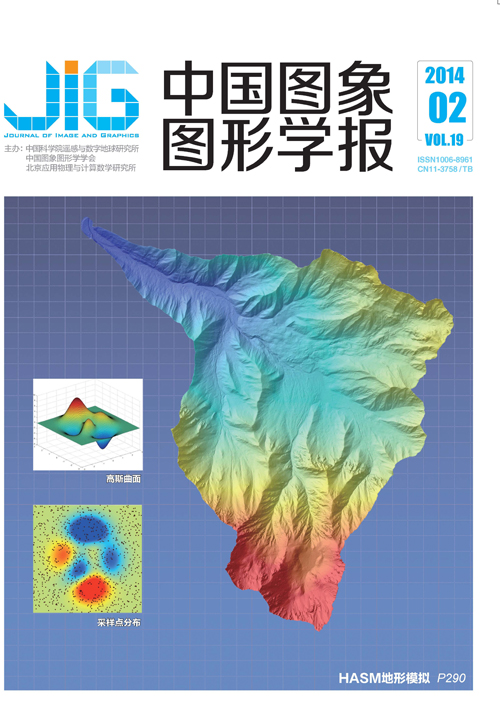
分段2维主成分分析的超光谱图像波段选择
张婧1, 孙俊喜1, 阮光诗2, 刘红喜3(1.长春理工大学电子信息工程学院, 长春 130022;2.长春理工大学电子信息工程学院, 长春 130022institution;3.清华信息科学与技术国家实验室普适计算研究部 清华大学计算机科学与技术系, 北京 100084) 摘 要
目的 超光谱图像具有极高的谱间分辨率,巨大的数据量给分类识别等后续处理带来很大压力。为了有效降低图像数据维数,提出基于分段2维主成分分析(2DPCA)的超光谱图像波段选择算法。方法 首先根据谱间相关性对原始图像进行波段分组,然后根据主成分反映每个光谱波段的信息比重分别对每组图像进行波段选择,从而实现超光谱图像的谱间降维。结果 该算法有效降低了超光谱图像的光谱维数,选择的波段明显反映出不同地物像元矢量的区别。结论 实验结果表明,该波段选择算法相对传统算法速度更快,并且较好地保留了原始图像的局部重要信息,对后续处理有积极意义。
关键词
Segmented 2DPCA algorithm for band selection of hyperspectral image
(College of Electronic Information Engineering, Changchun University of Science and Technology, Changchun 130022, China) Abstract
Objective It is well known that hyperspectral remote sensing technique is one of the breakthroughs in the earth observation. Hyperspectral images have the characteristics of contiguous spectral range and narrow spectrum interval. Typically, each image pixel is represented by hundreds of values, corresponding to various wavelengths. Today, with the wide application of hyperspectral images in many fields, such as surveillance, geology, environmental monitoring, and meteorology, the high dimensionality and huge amount data has become a key problem. Feature selection, especially band selection, plays an important role in hyperspectral image processing. In order to achieve the reduction of inter-spectral dimensionality effectively, a segmented two-dimensional principal component analysis (2DPCA) algorithm for band selection of hyperspectral image is proposed. Method The proposed algorithm is based on the traditional 2DPCA feature extraction method. It combines the advantages of 2DPCA and band selection. The whole band selection process can be divided into two steps. First, the spectral bands in a hyperspectral image are grouped into different clusters based on the correlation coefficient between them. Then, a band selection based on 2DPCA is taken for the bands in each group separately. In the second step, the image data dimensionality is converted in order to get a covariance matrix corresponding to the number of bands in each group. The number of selected bands is determined by the cumulative contribution rate of principal components. The bands are selected according to the amount of information of each band mapped into the principal components. This method has many advantages. It only needs to calculate all of the eigenvalues and eigenvectors of the covariance matrix, while it does not have to transform the original image matrix. Therefore it has a small amount of calculations and will not change the physical characteristics of the original image. Result According to the inter-spectral correlation coefficients, the original image data can be divided into four groups. The proposed algorithm extracts a total of 18 bands from the whole 189 in 34.937 seconds, effectively reduces the spectral dimension of hyperspectral image. While PCA, segmented PCA and 2DPCA extracts 13, 16, 11 bands respectively in 192.375, 50.829, 92.453 seconds. The bands selected by 2DPCA algorithm, which are very typical and contain a wealth of information, can reflect the difference between the pixel vectors corresponding to different surface features clearly. The new image that has fewer bands can be used in subsequent processing such as classification and recognition, the results of them will not be adversely affected. Conclusion On the basis of 2DPCA feature extraction algorithm, in this paper, we have realized the band selection algorithm based on the 2DPCA and the segmented 2DPCA. Furthermore, they are compared with the existing PCA-based and segmented PCA-based algorithm from the aspects of selected bands, time-consumation, and pixel vector curving. The experiment results show that the proposed algorithm can work faster than the traditional algorithm and the selected bands can preferably retain the local important information of the original image. It can be seen that the algorithm proposed is feasible, efficient and has a high practical value.
Keywords
|



 中国图象图形学报 │ 京ICP备05080539号-4 │ 本系统由
中国图象图形学报 │ 京ICP备05080539号-4 │ 本系统由